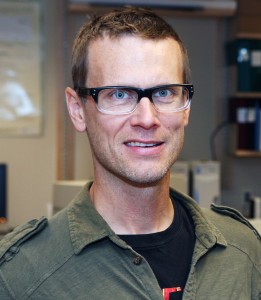Dec 14 2012
A made-in-Nova Scotia technology to allow for long-term automated monitoring of greenhouse gases is transforming the task into a practical process, even underground. Developed by Professor David Risk, of St. Francis Xavier University's (StFX) Department of Earth Sciences, the patented sensor-housings function throughout cold winters and without using much power—two significant benefits that competing technologies do not provide.
 Dr. David Risk
Dr. David Risk
Since 2006, Risk and his research group have been monitoring greenhouse gases at surface locations as far south as Antarctica and as far north as Alaska. Their specialized sensor-housings, called forced diffusion chambers, have also been in place at Saskatchewan's Weyburn-Midale CO2 storage site—the largest in the world. Risk and his research group at StFX originally developed the technology to measure gas fluxes in natural environments, including permafrost, where warming could release untold amounts of trapped carbon.
While carbon injection and storage technologies are relatively mature, for CCS to fulfill its role in climate change mitigation, good CO2 detection must also come of age. "Having direct sensing of CO2 would allow us to roll out the whole (CCS) technology in a much better way and with better confidence of containment," says Risk.
His next step is to marry the forced diffusion chambers with fibre-optic CO2 sensors. A Carbon Management Canada (CMC) funded research collaboration among investigators at five Canadian universities is supporting development of this novel direct-sensing technology. Peter Wild of the University of Victoria is the Lead Principal Investigator on the CMC-funded project, and is lending his expertise in fibre-optic sensing to the collaboration. CMC is a national network that funds research to reduce carbon emissions in the fossil energy industry and other large-scale emitters.
Current methods of direct-detection include periodically halting CO2-injection to take samples, or using a secondary well to monitor CO2 in the primary well where injection is taking place. In contrast, explains Risk, fibre-optic sensors would be much more practical and cost-effective.
Using Risk's membrane-based housings with fibre optic sensors offers the ability to estimate rates of CO2 migration and possibly also to act as selective filters, allowing CO2 to touch the sensors, but filtering out unwanted gases. His team will design the membrane-based housings in close collaboration with the fibre optics team.
Risk's experience monitoring CO2 in extreme environments will be invaluable when it comes to putting the sensors 1.5 kilometres down a well or potentially 2 kilometres across the ocean subsurface. High pressures and temperatures deep underground, not to mention interfering gases and chemical darkening of the fibre optics are some of the challenges that the researchers face.
An earth scientist with a knack for designing instruments and a passion for the great outdoors, Risk says he is one of the project team members who will "act as a conduit to ease those technologies into the real world." His role, he notes, includes keeping an eye out for confounding variables, "so what's happening on the bench can also happen in the environment."
The forced diffusion chambers are marketed through Forerunner Research, a company Risk established because there were no Canadian businesses operating in this highly specialized area.
"We really wanted to see (the technology) commercialized from Canada," Risk said. "Forerunner was formed when it was clear that there was no single receptor in the right market space, and with the right expertise . . . for made-in Canada commercialization, we had no options."
The company, which provides instruments as well as monitoring services, is poised to expand the technology's applications to monitoring gases at industrial sites, such as landfills, sour gas injection operations, and carbon capture and storage (CCS) sites.